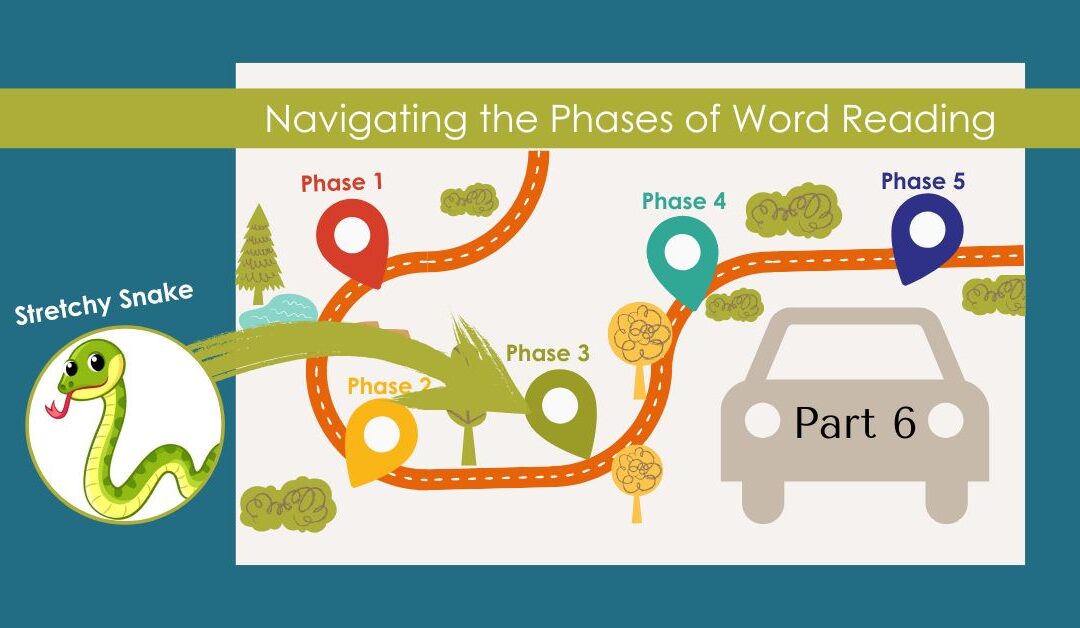Over the last several weeks, we have taken a close look at some familiar prompts–along with their Beanie Baby mascots–that are often used in an attempt to support students when they are stuck on a word. Our journey through these common prompts has been mapped out along Ehri’s Phases of Word Recognition (1987, 1995, 2002, 2005, 2017), which we introduced in this blog post and have revisited along the way.
Unfortunately, the prompts we have unpacked so far actually make learning to read harder for kids in the long run, either because they encourage them to slip back into earlier, more immature phases of word reading over the essential phase of full-alphabetic reading or because they nudge students to stretch into the consolidated phase before they are truly ready.
But today’s post is different. Today we spotlight Stretchy the Snake and some good news about a frequently used prompt!
The intention of Stretchy the Snake’s prompt is to encourage children to slide carefully across a word, using sound-by-sound decoding. While sliding across the word this way, children are set up to study the print from left-to-right and blend together the phonemes that each of the graphemes represents.
Typically, directions for Stretchy read something like this:
Say the sounds s-l-ow-l-y like a snake to figure out the word.
Basically, Stretchy represents a prompt to carefully “sound it out.” It’s a call to make and blend the individual sounds into a whole word.
What’s more, when we teach children to “say the sounds slowly,” we can also model and encourage them to hold out the sounds they can stretch–like a snake saying “ssssss”–which actually makes the work of blending easier.
Try it yourself. Say the sounds in the word man slowly, like Stretchy would. (Hint: It works even better if you don’t stop between the sounds).
mmmaaannn
Notice how much your stretching of the word sounds like the actual word–man. Now say the individual sounds, inserting a break between each one.
m – a – n
Notice how much farther from the word man this “choppy” sounding attempt gets you. This probably seems like a subtle, perhaps even unimportant, difference in the process, especially for you since you are already a proficient reader. But for beginning readers, the seemingly subtle difference in reading the sounds of an unknown word slowly with as much connection as possible and reading them quickly with breaks between can make all the difference.
Of course, not all sounds can be “stretched” or held out in this way. Think of the sounds most commonly represented by the letters B, C, T, and P. These are referred to as quick sounds or stop sounds. This difference in sounds is why the earliest blending work is best with words that do start with sounds that can be stretched, such as those most commonly represented by A, F, L, and N. Phonemes like these are called continuous sounds. For the very beginning readers, it is best to choose words that have mostly (or all) continuous sounds. If the words include any stop sounds, it’s best if they are at the end of the word, like the words in the list below.
map
rub
sat
fib
let
Whether working with stop or continuous sounds, success with stretching sounds across words is only helpful when students know how to pronounce phonemes without inserting extra vowel sounds in them. When they (or we) do add extra sounds (usually a short U sound), what students hear will be distorted in ways that will make it hard to figure out what the word actually is. The word man, for example, might end up sounding like this:
muh – a – nuh
Yikes! “Muhanuh” is even farther from the word man! It just doesn’t sound like a word in our speaking vocabulary. And if children can’t recognize their blending attempt as a word that is familiar, then they won’t be able to make sense of what they are reading.
So, Stretchy the Snake represents a prompt that is definitely worth keeping because it encourages children to tackle an unknown word by doing the important work of blending sound-by-sound, left-to-right. This is the work that helps them develop orthographic knowledge and sets them up to successfully move into the consolidated phase when they are ready.
Another good thing about Stretchy is that the metaphor of a snake, which actually stretches out the sound ssssss, includes a specific example of what you are trying to teach students. For most of the Beanie Baby prompts, it seems that the Beanie Baby can actually be a distraction. The other metaphors just don’t work as well.
But be careful. Although Stretchy can be a fun way to introduce stretching sounds, and it can help children understand the concept of s-l-ow and careful decoding, keep your prompt as clear as possible. Inserting the name of the character every time you prompt students by saying something like, “Remember your Stretchy the Snake strategy! Stretch each sound”–can create unnecessary cognitive “noise” and lead to confusion for beginning readers.
So, instead of complicating the prompt with Stretchy’s name or some elaboration, you can prompt readers with clean language that reminds them just what to do. The goal, of course, is for them to eventually sound out the word without either a plush toy or even a reminder. So keep it simple!
We suggest revising Stretchy’s directions a bit to read something like this:
Read the sounds slowly
and blend them together.
In the end, the focus should be on careful decoding, not on a mascot–even though Stretchy is a Beanie Baby we might consider keeping around.
Next week, we’ll be offering a bonus post in this series. There is one more Beanie Baby prompt worth encouraging children to try. We’re betting you can probably guess what it is!
Until then, we hope you are having a wonderful ssss-uuu-mmmmmm-errrrrrr!
❤️ Jan and Kari
References
Ehri, Linnea C. 1995. “Phases of Development in Learning to Read Words by Sight.” Journal of Research in Reading Research 18 (2): 116-125.
Ehri, Linnea C. 2005a. “Learning to Read Words: Theory, Findings, and Issues.” Scientific Studies of Reading, 9 (2): 167–188. doi: 10.1207/s1532799xssr0902_4
Ehri, Linnea C. 2005b. “Development of Sight Word Reading: Phases and Findings.” In M. J. Snowling and C. Hume (Eds.), The Science of Reading: A Handbook (pp. 135–154). Oxford, UK: Blackwell.
Ehri, Linnea C. 2017. “Orthographic Mapping and Literacy Development Revisited.” In Theories of Reading Development, ed. K. Cain, D. L. Compton, and R. K. Parrila (pp. 169-190). Amsterdam, The Netherlands: John Bejamins, doi: 10.1075/swll.15.08ehr.
Explore the whole blog series:
Showing Young Readers How to Navigate the Phases of Word Reading
Part 1: A Journey Through Ehri’s Phases
Part 2: Why Looking at the Pictures Isn’t as Helpful as We Thought
Part 3: Why Looking at the First Letter of the Word Isn’t Enough
Part 4: Problems With Skipping Words
Part 5: The Downsides of Asking Children to Search for Chunks in Words
Part 6: The Power of Teaching Students to Blend Words
BONUS: The Power of Teaching Readers to Try Alternate Sounds



As a Reading Recovery trained reading specialist, I deeply appreciate your thoughtful work in aligning teaching practices to research. One area I’d love to hear your thoughts on is that of explicitly explaining to beginning readers what to do with their mouths to produce particular sounds. I recognize that some children may need explicit direction in order to produce particular sounds. However, I question the efficacy of using lengthy language as part of routine teaching. Explaining all the positions of the mouth is part of the script for my district’s new phonics/phonemic awareness program. Your comment in this blog about eliminating excessive language hits home for me as a Reading Recovery trained teacher. Im looking forward to reading your upcoming blog posts!
Thank you.